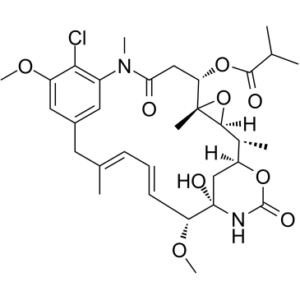Ansamitocin P-3 (Antibiotic C 15003P3′; Maytansinol butyrate)
This product is for research use only, not for human use. We do not sell to patients.

For small sizes, please check our retail website as below: www.invivochem.com
| Size | Price | Stock |
|---|---|---|
| 250mg | $950 | Check With Us |
| 500mg | $1450 | Check With Us |
| 1g | $2175 | Check With Us |
Cat #: V29720 CAS #: 66584-72-3 Purity ≥ 99%
Description: Ansamitocin P-3 (Maytansinol isobutyrate; NSC-292222; Antibiotic C 15003P3) is a potent microtubule/antimitotic inhibitor used as an warhead of ADC (antibody drug conjugate).
Top Publications Citing Invivochem Products
Publications Citing InvivoChem Products
Product Promise

- Physicochemical and Storage Information
- Protocol
- Related Biological Data
- Stock Solution Preparation
- Quality Control Documentation
| Molecular Weight (MW) | 635.14 |
|---|---|
| Molecular Formula | C32H43ClN2O9 |
| CAS No. | 66584-72-3 |
| Protocol | In Vitro | Ansamitocin P-3 (Antibiotic C 15003P3) potently inhibits the proliferation of MCF-7, HeLa, EMT-6/AR1, and MDA-MB-231 cells in cultures at half-maximum inhibitory concentrations of 20±3, 50±0.5, 140±17, and 150±1.1 pM, respectively. In addition, Ansamitocin P3 was found to bind to purified tubulin in vitro, with a dissociation constant (Kd) is 1.3±0.7 μM. Binding of Ansamitocin P3 induces conformational changes in tubulin. Ansamitocin P3 inhibits the proliferation of MCF-7, HeLa, EMT-6/AR1, and MDA-MB-231 cells in cultures in a concentration-dependent manner. Flow cytometry analysis of PI-stained cells showed that Ansamitocin P3 inhibits cell cycle progression in G2/M phase MCF-7 cells. For example, in the absence and presence of 50 and 100 pM Ansamitocin P3, 26%, 50%, and 70% of cells are in the G2/M phase, respectively |
|---|
These protocols are for reference only. InvivoChem does not
independently validate these methods.
| Solvent volume to be added | Mass (the weight of a compound) | |||
|---|---|---|---|---|
| Mother liquor concentration | 1mg | 5mg | 10mg | 20mg |
| 1mM | 1.5745 mL | 7.8723 mL | 15.7446 mL | 31.4891 mL |
| 5mM | 0.3149 mL | 1.5745 mL | 3.1489 mL | 6.2978 mL |
| 10mM | 0.1574 mL | 0.7872 mL | 1.5745 mL | 3.1489 mL |
| 20mM | 0.0787 mL | 0.3936 mL | 0.7872 mL | 1.5745 mL |
The molarity calculator equation
Mass(g) = Concentration(mol/L) × Volume(L) × Molecular Weight(g/mol)
Mass
=
Concentration
×
Volume
×
Molecular Weight*
The dilution calculator equation
Concentration(start)
×
Volume(start)
=
Concentration(final)
×
Volume(final)
This equation is commonly abbreviated as: C1 V1 = C2 V2
Concentration(start)
C1
×
Volume(start)
V1
=
Concentration(final)
C2
×
Volume(final)
V2
Step One: Enter information below
Dosage mg/kg
Average weight of animals g
Dosing volume per animal µL
Number of animals
Step Two: Enter the in vivo formulation
%DMSO
+
%
+
%Tween 80
+
%ddH2O
Calculation Results:
Working concentration:
mg/ml;
Method for preparing DMSO master liquid:
mg
drug pre-dissolved in
µL
DMSO(Master liquid concentration
mg/mL)
,Please contact us first if the concentration exceeds the DMSO solubility of the batch of drug.
Method for preparing in vivo formulation:
Take
µL
DMSO master liquid, next add
µL
PEG300, mix and clarify, next add
µL
Tween 80,mix and clarify, next add
µL
ddH2O,mix and clarify.
Note:
- (1) Please be sure that the solution is clear before the addition of next solvent. Dissolution methods like vortex, ultrasound or warming and heat may be used to aid dissolving.
- (2) Be sure to add the solvent(s) in order.




































